句子成分分析
句子成分分析整理
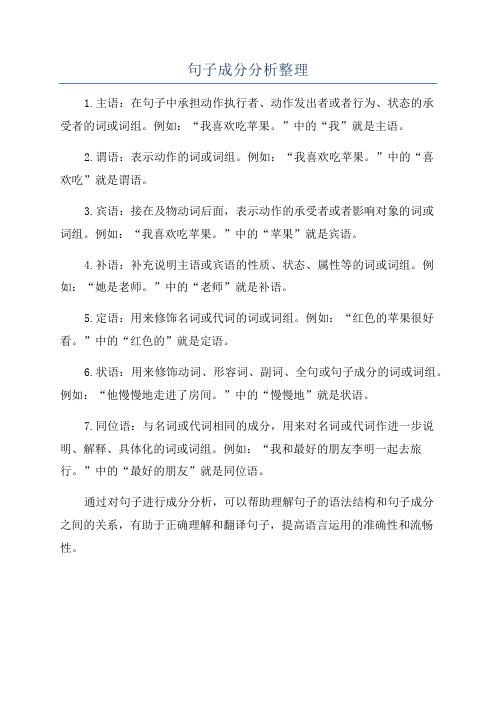
句子成分分析整理
1.主语:在句子中承担动作执行者、动作发出者或者行为、状态的承
受者的词或词组。
例如:“我喜欢吃苹果。
”中的“我”就是主语。
2.谓语:表示动作的词或词组。
例如:“我喜欢吃苹果。
”中的“喜
欢吃”就是谓语。
3.宾语:接在及物动词后面,表示动作的承受者或者影响对象的词或
词组。
例如:“我喜欢吃苹果。
”中的“苹果”就是宾语。
4.补语:补充说明主语或宾语的性质、状态、属性等的词或词组。
例如:“她是老师。
”中的“老师”就是补语。
5.定语:用来修饰名词或代词的词或词组。
例如:“红色的苹果很好看。
”中的“红色的”就是定语。
6.状语:用来修饰动词、形容词、副词、全句或句子成分的词或词组。
例如:“他慢慢地走进了房间。
”中的“慢慢地”就是状语。
7.同位语:与名词或代词相同的成分,用来对名词或代词作进一步说明、解释、具体化的词或词组。
例如:“我和最好的朋友李明一起去旅行。
”中的“最好的朋友”就是同位语。
通过对句子进行成分分析,可以帮助理解句子的语法结构和句子成分
之间的关系,有助于正确理解和翻译句子,提高语言运用的准确性和流畅性。
句子成分分析

句子成分分析句子成分分析是语法学习中重要的组成部分,是对句子内部结构进行解析和深入理解的过程。
句子成分分析手段可以简要扼要地描述出句子的结构,从而更直观、更明确地把握句子的意义、类型以及把握句子中各种成分之间彼此关系的一种解析方法。
一、句子成分概述英语句子中各个成分之间有着复杂而严格的关系,句子的含义取决于句子的各个成分的状态、地位,以及其构成的句法格式。
因此,句子成分分析是探究句子性质和句子结构的一项重要工作。
当然,它也是学习语言和文字表达能力的基础。
根据不同语言的结构特点,句子成分分析应当有不同的研究内容,而在英语学习中,句子成分一般可以分为主语、谓语、宾语、定语、状语等六大类,形式上也可以分为一般句子的名词性结构和动词性结构。
二、句子成分分析研究1、主语主语指在句子中承担谓语动作的实体,是句子的核心成分,也是一个句子的灵魂所在。
通过对主语的认知,可以判断句子的神态,而对句子主语的正确理解,也是对句子含义的正确理解的关键所在。
根据它所承担的句子动作,主语分为主动句和被动句,除此之外,主语还可以分为主体主语、客体主语和双重主语等不同类型。
2、谓语谓语是句子的核心成分,也是句子的主语的动作表达所在。
它是句子最重要的词,它对句子的意义起着重要的作用,它决定了句子的时态,也决定了句子的语态。
语在句子成分分析中,可以分为实义动词和系动词,实义动词包括助动词、关联动词、情态动词等,其中,助动词有“be、have、do”等,关联动词有“seem、appear、become、get、go、turn”等,情态动词有“can、may、must”等。
3、宾语宾语是指被动作的对象,是一个句子中实现动作的一方,只要有宾语,就要有一个动作的发出者,即主语,一般情况下,它都是位于谓语之后的成分,如果句子中有宾语,那么一定要有主语,它们会形成一种完整的句子结构。
宾语的类型也是有的,它不仅可以分为直接宾语和间接宾语,还可以分为宾语补足语和宾语从句以及宾语固定语等多种形式。
句子成分分析方法总结大全

句子成分分析方法总结大全句子成分分析是语法学中的重要内容,通过分析句子中各个成分的语法功能和关系,可以深入理解句子的结构和语义。
本文将对句子成分分析的常用方法进行总结和介绍。
一、句子成分分析的定义和意义句子成分指的是句子中具有特定语法功能和语义关系的各个组成部分,如主语、谓语、宾语、补语、定语、状语等。
句子成分分析的目的在于揭示句子结构的组织方式和各个成分之间的关系,以帮助我们理解句子的意义和语法特点。
句子成分分析方法的好坏直接影响着对句子的深刻理解和准确识别,对于语言学习、文学理解、语言教学等领域都具有重要意义。
二、常用的句子成分分析方法1. 语义分析法:通过分析句子中各个成分的语义意义来确定其语法功能和关系。
这种方法注重从句子整体的意义出发,通过掌握词语的意义和上下文的语义关系来判断句子成分。
2. 语法分析法:通过句法规则和语法现象来判断句子成分的功能和关系。
这种方法注重掌握句法规则和语法结构,通过分析语法现象和句子结构来确定句子成分。
3. 上下文依存分析法:通过分析句子中成分之间的上下文关系来确定其语法功能和关系。
这种方法注重把握句子成分之间的逻辑关系和依存关系,通过分析成分在句子中的位置和连接关系来判断句子成分。
4. 句法树分析法:通过构建句子的句法树来分析句子的成分和关系。
句法树是一种以树状结构来呈现句子成分和句子结构的图表,通过观察句子树的分支和节点来判断句子成分的功能和关系。
5. 语料库分析法:通过收集和分析大量语料库中的语法现象和句子结构来进行句子成分分析。
这种方法注重从大数据角度出发,通过观察和统计语料库中的句子结构和成分特点来进行句子成分分析。
以上述方法为基础,还可以结合语法规则、句子类型、词法特点等进行句子成分分析,从多个角度综合考量,提高分析的准确性和全面性。
三、句子成分分析的步骤和技巧进行句子成分分析时,可以按照以下步骤进行:1. 确定主干:通过确定句子中的谓语来确定句子的主干,然后根据主干来分析其他成分。
句子成分分析总结大全

句子成分分析总结大全句子是语言表达的基本单位,由一个或多个单词组成。
为了能够准确理解和运用句子,我们需要对句子中的各个成分进行分析。
本文将介绍句子成分的常见分类和特点,以帮助读者更好地理解和运用句子成分。
一、主语(Subject)主语是句子中起主导作用的词或词组,通常回答“谁”或“什么”提问。
主语通常是句子的主题或动作的执行者。
例如:- "小明跑步" - 这里的主语是"小明",执行了"跑步"的动作。
- "书架上的书掉下来了" - 这里的主语是"书架上的书",发生了"掉下来"的动作。
二、谓语(Predicate)谓语是句子中表达动作或状态的词或词组,通常回答“做了什么”提问。
谓语通常与主语呼应,构成句子的核心。
例如:- "小明跑步" - 这里的谓语是"跑步",表达了动作。
- "书架上的书掉下来了" - 这里的谓语是"掉下来",表达了状态。
三、宾语(Object)宾语是句子中受到动作影响的人、事物或概念,通常回答“被做了什么”提问。
宾语通常是及物动词的补充。
例如:- "小明吃饭" - 这里的宾语是"饭",受到了"吃"的动作影响。
- "他看见了一只小猫" - 这里的宾语是"一只小猫",被"看见"了。
四、定语(Adjective)定语是修饰名词或代词的词或词组,通常回答“怎样的”提问。
定语可以提供更多关于名词或代词的描述或限定。
例如:- "一本有趣的书" - 这里的定语是"有趣的",修饰了"书"。
- "漂亮的花朵" - 这里的定语是"漂亮的",修饰了"花朵"。
句子成分分析技巧

句子成分分析技巧句子成分分析是语言学中非常重要的一部分,它帮助我们理解句子的结构和语法规则。
正确地进行句子成分分析可以帮助我们更好地理解和运用语言。
下面将介绍一些句子成分分析的技巧和方法。
1. 定语和状语的分析句子中的定语和状语是修饰名词和动词的成分。
定语一般放在名词前作修饰,而状语则一般放在句子中作修饰。
在分析时,需要注意定语和状语的功能和位置。
例如,在句子"I have a big house"中,"big"是定语修饰名词"house";而在句子"I ran quickly"中,"quickly"是状语修饰动词"ran"。
2. 主语和谓语的分析句子中的主语是句子的中心内容,谓语是描述主语的动作或状态。
在分析时,需要准确确定主语和谓语的成分。
例如,在句子"John is reading a book"中,"John"是主语,"is reading"是谓语;而在句子"They are playing football"中,"They"是主语,"are playing"是谓语。
3. 宾语和宾语补足语的分析句子中的宾语通常是动作的承受者或者是描述状态的对象。
在分析时,需要分辨宾语是及物动词的直接宾语还是间接宾语,以及宾语补足语的类型。
例如,在句子"She bought a book"中,"a book"是及物动词"bought"的直接宾语;而在句子"He gave me a gift"中,"me"是及物动词"gave"的间接宾语,"a gift"是宾语补足语。
句子成分分析方法知识点总结大全
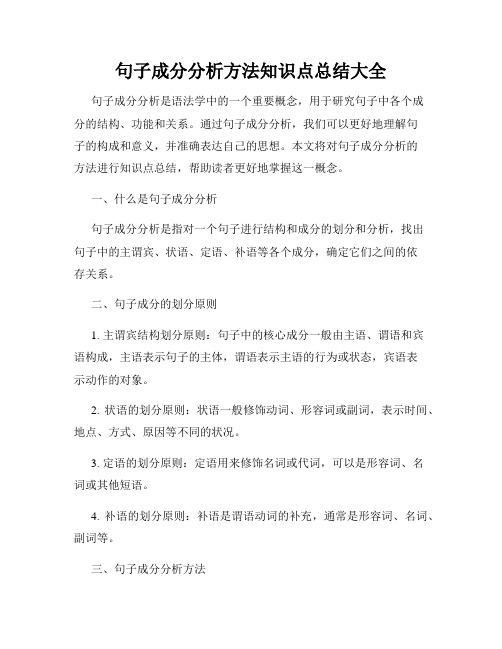
句子成分分析方法知识点总结大全句子成分分析是语法学中的一个重要概念,用于研究句子中各个成分的结构、功能和关系。
通过句子成分分析,我们可以更好地理解句子的构成和意义,并准确表达自己的思想。
本文将对句子成分分析的方法进行知识点总结,帮助读者更好地掌握这一概念。
一、什么是句子成分分析句子成分分析是指对一个句子进行结构和成分的划分和分析,找出句子中的主谓宾、状语、定语、补语等各个成分,确定它们之间的依存关系。
二、句子成分的划分原则1. 主谓宾结构划分原则:句子中的核心成分一般由主语、谓语和宾语构成,主语表示句子的主体,谓语表示主语的行为或状态,宾语表示动作的对象。
2. 状语的划分原则:状语一般修饰动词、形容词或副词,表示时间、地点、方式、原因等不同的状况。
3. 定语的划分原则:定语用来修饰名词或代词,可以是形容词、名词或其他短语。
4. 补语的划分原则:补语是谓语动词的补充,通常是形容词、名词、副词等。
三、句子成分分析方法1. 词法分析法:句子成分分析的第一步是对句子进行词法分析,确定句子中的各个词语的词性和功能。
2. 句法分析法:句法分析是通过句子的语法规则和成分之间的依存关系,确定句子中各个成分的结构和功能。
3. 上下文分析法:有时候句子中的某个词语的含义和功能需要通过上下文来确定,特别是一些具有歧义的词语。
4. 语义分析法:句子成分分析中,我们还需要注意句子的语义,通过对句子的意思的理解和推断,确定句子成分的语义角色。
四、实例分析以下是一些句子成分分析的实例,通过对这些句子进行分析,我们可以更好地理解句子成分的划分和分析方法。
1. 他读书很用功。
主谓宾结构划分原则:主语为“他”,谓语为“读书”,宾语为“很用功”。
2. 小明坐在椅子上。
主谓宾结构划分原则:主语为“小明”,谓语为“坐”,宾语为“椅子上”。
3. 天气虽然很冷,但是他还是出门了。
状语的划分原则:句子中的“虽然很冷”和“但是”都是状语,修饰整个句子。
句子成分分析的基本概念和方法

句子成分分析的基本概念和方法句子是语言表达的基本单位,由一系列词语组成。
每个词语在句子中都担当着不同的语法成分,比如主语、谓语、宾语等。
句子成分分析是研究句子结构中各个成分的语法关系和功能的一门语言学方法。
通过对句子中的成分进行分析,可以更好地理解句子的结构和含义。
本文将介绍句子成分分析的基本概念和方法。
一、句子成分的定义和分类在句子中,每个词语都担当着不同的成分角色,从而组成一个完整的句子。
根据功能和语法关系,句子成分可以分为主语、谓语、宾语、定语、状语、补语和同位语等。
1. 主语:主语是句子中的核心成分,它通常回答“谁”或“什么”的问题。
例如,“小明在跑步”中的“小明”就是主语。
2. 谓语:谓语是句子中的核心动词或动词短语,它通常回答“做什么”或“怎么样”的问题。
例如,“小明在跑步”中的“在跑步”就是谓语。
3. 宾语:宾语是句子中动词的直接承受者,它通常回答“受到什么”的问题。
例如,“小明吃苹果”中的“苹果”就是宾语。
4. 定语:定语是用来修饰名词或代词的,通常位于被修饰词之前或之后。
例如,“大房子里有一只猫”中的“大”就是定语。
5. 状语:状语是修饰动词、形容词、副词等表示状态、程度、方式等的词语。
例如,“小明慢慢地跑回家”中的“慢慢地”就是状语。
6. 补语:补语是用来补充说明主语或宾语的成分,通常位于动词之后。
例如,“他被选为班长”中的“班长”就是补语。
7. 同位语:同位语是用来同位修饰名词的词或词组,它通常出现在被修饰名词的后面。
例如,“他的前女友,名叫小红”中的“名叫小红”就是同位语。
二、句子成分分析的方法句子成分分析的方法主要包括词法分析和句法分析两个方面。
1. 词法分析:词法分析是对句子中的每个词语进行分析和标注其成分的过程。
通过对句子中的每个词语进行词性判断和成分标注,可以初步确定每个词语在句子中的语法角色。
一般来说,名词、代词、形容词等常常作为定语或宾语;动词则通常是谓语或宾语;副词则常常是状语等。
(完整版)句子成分分析

句子成分分析一、主语多表示人或事物,是句子里被陈述的对象,在句首能回答“谁”或者“什么”等问题。
可由名词、代词、数词、名词化的形容词、不定式、动名词和主语从句等来承担。
例如:(1)今天晚上‖ 特别冷。
主语(偏正短语)谓语(2)[明天这个时候],我们‖就可以走出戈壁滩了。
状语(时间)主语(代词)谓语以动作、性状或事情做陈述的对象的主语句。
例如:(1)笑‖是具有多重意义的语言。
主语(动词)谓语(2)公正廉洁‖是公职人员行为的准则。
主语(形容词联合短语)谓语二、谓语是用来陈述主语的,能回答主语“怎么样”或“是什么”等问题。
谓语可以由动词来担任,一般放在主语的后面。
(1)动词性词语经常做谓语。
例如:他‖[只]答应了<一声>。
主语谓语(状语+动词+补语)南海一中‖留下<过>(许多人)的梦。
主语谓语(动词+补语+定语+宾语)我‖[最近]去<了><一趟>北京。
主语谓语(状+动+补+宾)(2)形容词性词语也经常做谓语。
例如:太阳‖热烘烘的。
主语谓语(形容词+的)人参这种植物,‖娇嫩<极了>。
主语谓语(形容词+补语)说话‖[要]简洁<些>。
主语谓语(状语+形容词+补语)(3)主谓短语做谓语。
例如:这件事‖大家都赞成。
主语谓语(主谓短语)任何困难‖她都能克服。
主语谓语(主谓短语)大家的事情‖大家办。
主语谓语(主谓短语)(4)名词性词语做谓语。
这种情况很少见,有一定的条件限制。
可参考文言文中的判断句。
例如:鲁迅‖浙江绍兴人。
主语谓语(名词短语)明天‖教师节。
主语谓语(名词)她‖大眼睛,红脸蛋。
主语谓语(定中短语,表容貌)三、宾语往往表示动作支配的对象,并且总是处在动词的后头。
可由名词、代词、数词、名词化的形容词、不定式、动名词、宾语从句等来担任。
(1)名词性宾语。
例如:玫瑰花我给你们俩十朵,给你紫红的,给她粉红的。
近宾远宾近宾远宾近宾远宾(2)谓词性宾语。
分析句子成分的技巧和口诀
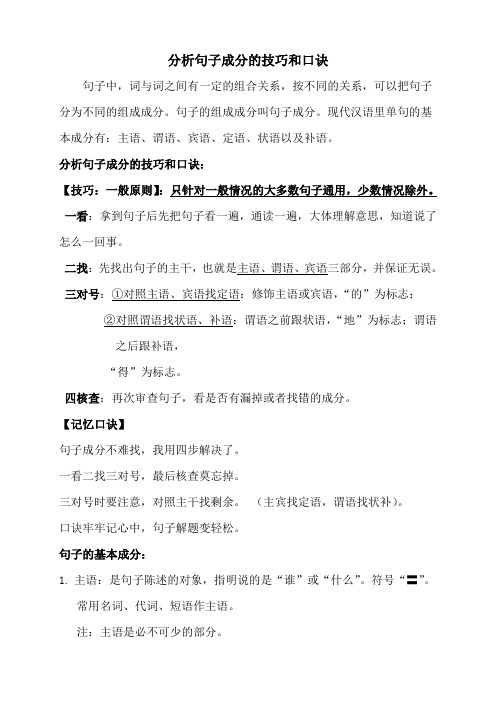
分析句子成分的技巧和口诀句子中,词与词之间有一定的组合关系,按不同的关系,可以把句子分为不同的组成成分。
句子的组成成分叫句子成分。
现代汉语里单句的基本成分有:主语、谓语、宾语、定语、状语以及补语。
分析句子成分的技巧和口诀:【技巧:一般原则】:只针对一般情况的大多数句子通用,少数情况除外。
一看:拿到句子后先把句子看一遍,通读一遍,大体理解意思,知道说了怎么一回事。
二找:先找出句子的主干,也就是主语、谓语、宾语三部分,并保证无误。
三对号:①对照主语、宾语找定语:修饰主语或宾语,“的”为标志;②对照谓语找状语、补语:谓语之前跟状语,“地”为标志;谓语之后跟补语,“得”为标志。
四核查:再次审查句子,看是否有漏掉或者找错的成分。
【记忆口诀】句子成分不难找,我用四步解决了。
一看二找三对号,最后核查莫忘掉。
三对号时要注意,对照主干找剩余。
(主宾找定语,谓语找状补)。
口诀牢牢记心中,句子解题变轻松。
句子的基本成分:1.主语:是句子陈述的对象,指明说的是“谁”或“什么”。
符号“〓”。
常用名词、代词、短语作主语。
注:主语是必不可少的部分。
①中国是个资源大国。
(名词)②我们今天去野外郊游吧!(代词)③鱼和熊掌不可兼得。
(短语:并列)2.谓语:是陈述主语的,说明主语“是什么”或“怎么样”。
符号“—”。
常用动词、形容词、短语作谓语。
注:谓语也是必不可少成分。
①我赞美白杨树。
(动词)②蜜蜂是辛勤的劳作者。
(判断动词)③张俊豪非常可爱。
(形容词)④在这里,我重申和表明自己的坚定立场。
(短语:并列)⑤你仔细观察一下题目。
(短语:偏正)3.宾语:表示动作、行为涉及的人或者事物,回答“谁”或“什么”一类的问题。
符号“﹏”。
常用名词、代词、短语作宾语注:一般在动词后。
①我的好朋友是王小明。
(名词)②妈妈从来不打骂我们。
(代词)③教师的后面是操场和花园。
(短语:并列)4.定语:是名词前的附加成分,用来修饰、限制名词,表示人或事务的性状、数量、所属等。
句子成分分析方法

句子成分分析方法句子成分分析是语言学的重要分支之一,它研究的是句子中不同成分的组合和关系。
正确的句子成分分析可以帮助我们理解句子的结构和意义,提高语言表达的准确性。
本文将介绍几种常见的句子成分分析方法。
一、上下文分析法上下文分析法是一种根据句子上下文来确定句子成分的方法。
通过观察句子前后的语境,我们可以推测出句子中不同成分之间的关系,进而准确地判断句子成分。
例如,对于句子“他拿起了一本书”,我们可以通过上下文分析判断出“他”是主语,“拿起了”是谓语,“一本书”是宾语。
二、语法分析法语法分析法是一种根据句子的语法规则来确定句子成分的方法。
通过对句子的语法结构进行分析,我们可以准确地确定句子中的主语、谓语、宾语等成分。
例如,在英语中,根据主谓宾语的语法规则,我们可以确定句子“Mary ate an apple”中,“Mary”是主语,“ate”是谓语,“an apple”是宾语。
三、成分替换法成分替换法是一种通过成分替换来确定句子成分的方法。
通过将句子中的某个成分替换成其他词或短语,我们可以判断该成分在句子中的作用。
例如,在句子“我给了他一本书”,我们可以通过将“给了”改成“看了”来判断出“他”是受事者,即宾语。
四、句子成分关系判断法句子成分关系判断法是一种通过观察句子成分之间的关系来确定句子成分的方法。
通过分析不同句子成分之间的语义关联和语序关系,我们可以准确地判断句子成分的功能。
例如,在句子“小明昨天买了一本小说”,我们可以通过观察“昨天”和“买了”之间的关系来判断出“昨天”是时间状语。
综上所述,句子成分分析方法有许多种,包括上下文分析法、语法分析法、成分替换法和句子成分关系判断法等。
选择合适的方法,可以帮助我们准确地理解和使用句子成分,提高语言表达的准确性和流畅性。
句子成分分析是语言学研究的重要内容,也是语言学习过程中必不可少的一部分。
通过深入了解和掌握句子成分分析方法,我们可以更好地理解和运用句子,提高语言水平。
句子成分分析汇总
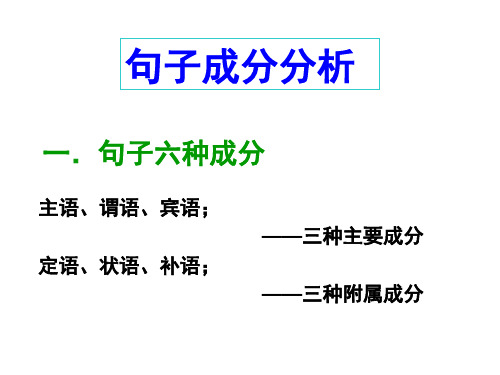
主谓短语
由名词、代词与动词或形容词一起组成的。 前后是陈述与被陈述的关系。
对象+干什么(怎么样)
凳子坏了 我们上街
阳光灿烂
举止稳重
动宾短语
由动词和后面的宾语组成,前后是支 配和被支配的关系。
敬畏生命 夸奖我
有幽默感
后补短语
由动词、形容词和后面其补充说明作用的成分 一起组成的。起补充说明作用的成分是补语。 动补短语:动+补
例如:
2、谓语
谓语也是句子的主要成分。谓语对主语加 以陈述,表示主语“怎么样”或者“是什 么”。谓语通常是动词、形容词或者名词, 有时偏正短语也可以做谓语。
例如:
溪水涨起来了。(动词) 花儿红艳艳。(形容词) 这张桌子三条腿。(偏正短语)
3、宾语
宾语是动词的连带成分,表示动作、行为所涉 及的对象。常由名词、代词跟在动词后边,或 者是名词代词借助介词用在动词前边;另外表 示开始、停止的动词和表示活动的动词可以做 宾语。
给下面划分出短语类型
泻在这一片叶子和花上
这就是中国的脊梁
句子成分的标识符号
主语:“ 谓语:“——
宾语:“
” 划在主语下面 ” 划在谓语下面 ” 划在宾语下
面 定语:“()” 用在定语前后 状语:“[ ]” 用在状语前后 补语:“〈〉” 用在补语前后 注意:划分句子成分一般先划出主、谓、宾; 然
句子成分分析实例2
例句:全体同学都做完了语法作业。 全体同学都做完了语法作业。 全体 同学 都 做 完 了 语法 作业
注意:划分句子成分一般先划出主、 谓、宾; 然后再找出定、状、补。
句子成分分析
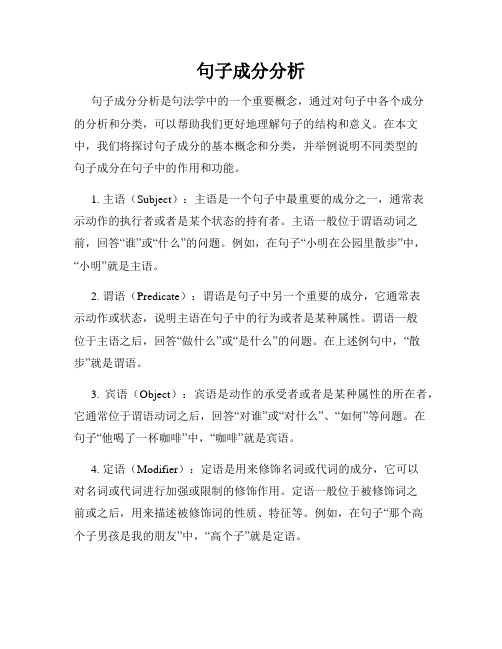
句子成分分析句子成分分析是句法学中的一个重要概念,通过对句子中各个成分的分析和分类,可以帮助我们更好地理解句子的结构和意义。
在本文中,我们将探讨句子成分的基本概念和分类,并举例说明不同类型的句子成分在句子中的作用和功能。
1. 主语(Subject):主语是一个句子中最重要的成分之一,通常表示动作的执行者或者是某个状态的持有者。
主语一般位于谓语动词之前,回答“谁”或“什么”的问题。
例如,在句子“小明在公园里散步”中,“小明”就是主语。
2. 谓语(Predicate):谓语是句子中另一个重要的成分,它通常表示动作或状态,说明主语在句子中的行为或者是某种属性。
谓语一般位于主语之后,回答“做什么”或“是什么”的问题。
在上述例句中,“散步”就是谓语。
3. 宾语(Object):宾语是动作的承受者或者是某种属性的所在者,它通常位于谓语动词之后,回答“对谁”或“对什么”、“如何”等问题。
在句子“他喝了一杯咖啡”中,“咖啡”就是宾语。
4. 定语(Modifier):定语是用来修饰名词或代词的成分,它可以对名词或代词进行加强或限制的修饰作用。
定语一般位于被修饰词之前或之后,用来描述被修饰词的性质、特征等。
例如,在句子“那个高个子男孩是我的朋友”中,“高个子”就是定语。
5. 状语(Adverbial):状语是用来修饰动词、形容词或者其他副词的成分,它可以说明动作发生的时间、地点、方式、原因等。
状语可以出现在句子的不同位置,例如,“昨天”在句子“我昨天去了图书馆”中就是状语。
6. 补语(Complement):补语是用来补充说明主语或宾语的成分,它通常出现在谓语动词之后,用来补充主语或宾语的属性、状态等。
例如,在句子“她是一位医生”中,“一位医生”就是补语。
除了上述常见的句子成分,还有一些其他的语法成分,如状语补语、独立主格、同位语等,它们在句子中起着不同的作用和功能。
总结起来,句子成分是句子中的各个主要成分,它们协同作用,构成完整的句子结构。
句子成分分析
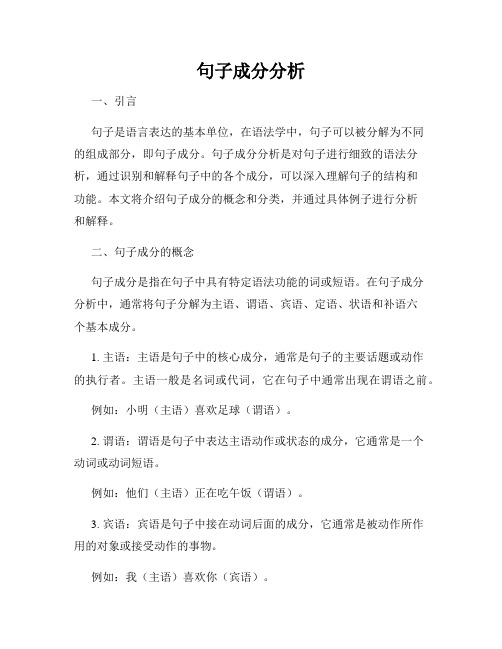
句子成分分析一、引言句子是语言表达的基本单位,在语法学中,句子可以被分解为不同的组成部分,即句子成分。
句子成分分析是对句子进行细致的语法分析,通过识别和解释句子中的各个成分,可以深入理解句子的结构和功能。
本文将介绍句子成分的概念和分类,并通过具体例子进行分析和解释。
二、句子成分的概念句子成分是指在句子中具有特定语法功能的词或短语。
在句子成分分析中,通常将句子分解为主语、谓语、宾语、定语、状语和补语六个基本成分。
1. 主语:主语是句子中的核心成分,通常是句子的主要话题或动作的执行者。
主语一般是名词或代词,它在句子中通常出现在谓语之前。
例如:小明(主语)喜欢足球(谓语)。
2. 谓语:谓语是句子中表达主语动作或状态的成分,它通常是一个动词或动词短语。
例如:他们(主语)正在吃午饭(谓语)。
3. 宾语:宾语是句子中接在动词后面的成分,它通常是被动作所作用的对象或接受动作的事物。
例如:我(主语)喜欢你(宾语)。
4. 定语:定语是句子中用来修饰名词或代词的成分,它通常在名词或代词前面。
例如:这本书(定语)很有趣。
5. 状语:状语是句子中用来表示时间、地点、方式、原因等修饰性成分,它通常用来补充说明谓语或其他成分的情况。
例如:他们(主语)在公园里(状语)散步。
6. 补语:补语是句子中用来补充说明主语或宾语特征和状态的成分,它通常位于系动词之后。
例如:她(主语)是一位医生(补语)。
三、句子成分的分类根据句子成分的作用和性质,可以进一步细分句子成分的类型。
1. 核心成分:主语和谓语是句子的核心成分,它们直接构成了句子的基本结构和主要信息。
例如:小猫(主语)睡觉(谓语)。
2. 附加成分:定语、状语和补语是句子的附加成分,它们在句子中起到修饰和补充的作用。
例如:这支花(定语)非常美丽。
3. 补充成分:宾语是句子的补充成分,它用来表示动作所作用的对象。
例如:我(主语)买了一本书(宾语)。
四、句子成分的例子分析为了更好地理解句子成分的概念和分类,我们来分析一些具体的例子。
句子成分分析

句子成分分析句子成分分析是语文学习中十分重要的一部分,它帮助我们理解句子的结构和成分之间的关系。
通过对句子成分的分析,我们可以更好地理解句子的意思,提高阅读和写作能力。
本文将从句子成分的基本概念、常见句子成分及其特点以及成分分析的实际应用等方面进行探讨。
一、句子成分的基本概念句子成分是指构成句子的各个部分,包括主语、谓语、宾语、定语、状语、补语等。
每个成分在句子中都有其独特的语法功能和句法位置。
下面我们来逐一介绍这些成分。
1. 主语:主语是句子中的核心成分,它通常回答“谁”或“什么”的问题。
主语一般位于句子的开头,它可以是一个名词、代词、数词、不定式、动名词等。
2. 谓语:谓语是句子中的核心成分,它通常回答“做什么”或“是什么”的问题。
谓语一般位于主语之后,它可以是一个动词、形容词、副词等。
3. 宾语:宾语是句子中的重要成分,它通常回答“受到谁或什么”的问题。
宾语一般位于谓语之后,它可以是一个名词、代词、数词、不定式等。
4. 定语:定语是句子中的修饰成分,它通常回答“怎样的”或“哪一个”的问题。
定语一般位于被修饰的词之前,它可以是一个形容词、副词、介词短语等。
5. 状语:状语是句子中的修饰成分,它通常回答“怎样”、“在哪里”、“为什么”等问题。
状语可以位于句子的任何位置,它可以是一个副词、介词短语、状语从句等。
6. 补语:补语是句子中的补充成分,它通常用来补充说明主语或宾语的特点、状态或身份。
补语可以是一个形容词、名词、副词等。
二、常见句子成分及其特点1. 主语的特点:主语通常是句子的话题,它在句子中起到命名、指代或代词的作用。
主语可以是单数或复数形式,也可以是第一、第二或第三人称。
2. 谓语的特点:谓语是句子的核心,它可以是及物动词、不及物动词、系动词等。
谓语的时态、语态和语气等可以根据句子的需要进行变化。
3. 宾语的特点:宾语通常是句子中的动作承受者或受益者,它可以是直接宾语或间接宾语。
宾语的数、格和性等要与谓语相匹配。
句子成分分析
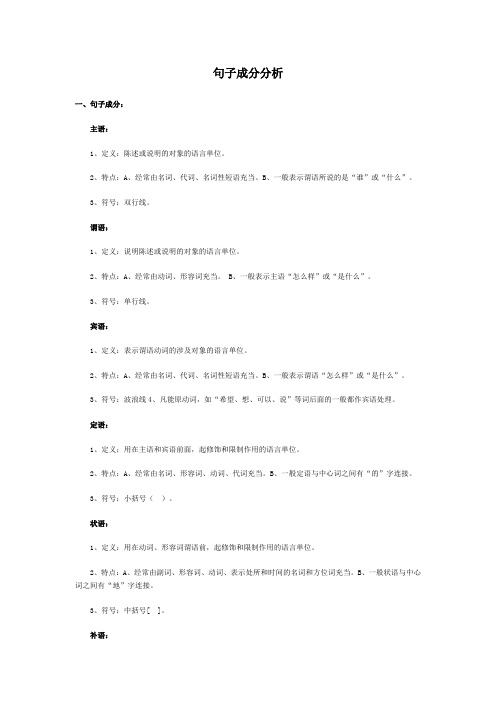
句子成分分析一、句子成分:主语:1、定义:陈述或说明的对象的语言单位。
2、特点:A、经常由名词、代词、名词性短语充当。
B、一般表示谓语所说的是“谁”或“什么”。
3、符号:双行线。
谓语:1、定义:说明陈述或说明的对象的语言单位。
2、特点:A、经常由动词、形容词充当。
B、一般表示主语“怎么样”或“是什么”。
3、符号:单行线。
宾语:1、定义:表示谓语动词的涉及对象的语言单位。
2、特点:A、经常由名词、代词、名词性短语充当。
B、一般表示谓语“怎么样”或“是什么”。
3、符号:波浪线4、凡能原动词,如“希望、想、可以、说”等词后面的一般都作宾语处理。
定语:1、定义;用在主语和宾语前面,起修饰和限制作用的语言单位。
2、特点:A、经常由名词、形容词、动词、代词充当。
B、一般定语与中心词之间有“的”字连接。
3、符号:小括号()。
状语:1、定义:用在动词、形容词谓语前,起修饰和限制作用的语言单位。
2、特点:A、经常由副词、形容词、动词、表示处所和时间的名词和方位词充当。
B、一般状语与中心词之间有“地”字连接。
3、符号:中括号[ ]。
补语:1、定义:谓语后面的附加成分,对谓语起补充说明作用,回答“怎么样”、“多久”、“多少”(时间、处所、结果)之类问题的语言单位。
2、特点:A、经常由动词、形容词副词充当。
B、一般补语与中心词之间有“得”字连接。
3、符号:单书名号〈〉。
二、句子主干:包括:主语、谓语、宾语。
三、找句子主干要注意的问题:1、碰到有否定词“不、没、没有”等的句子要把否定词保留在句子主干中。
如:我不看黄色书刊。
主干:我不看书刊。
2、主语、谓语、宾语的中心词是并列结构的,要把整个并列结构找出。
如:赵州桥高度的技术水平和不朽的艺术价值,充分显示了我国劳动人民的智慧和力量。
主干:技术水平和艺术价值显示智慧和力量。
3、主谓短语作宾语的句子应把整个短语保留在主干里。
如:我清楚地看见他来了。
主干:我看见他来了。
四、练习:1、判断下列句子的主干划得正确与否, 对“√”, 错“×”①地势渐渐更加陡起来。
汉语句子成分分析
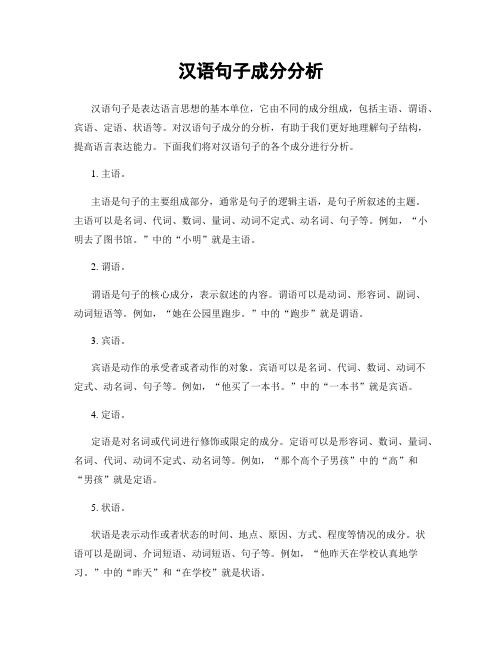
汉语句子成分分析汉语句子是表达语言思想的基本单位,它由不同的成分组成,包括主语、谓语、宾语、定语、状语等。
对汉语句子成分的分析,有助于我们更好地理解句子结构,提高语言表达能力。
下面我们将对汉语句子的各个成分进行分析。
1. 主语。
主语是句子的主要组成部分,通常是句子的逻辑主语,是句子所叙述的主题。
主语可以是名词、代词、数词、量词、动词不定式、动名词、句子等。
例如,“小明去了图书馆。
”中的“小明”就是主语。
2. 谓语。
谓语是句子的核心成分,表示叙述的内容。
谓语可以是动词、形容词、副词、动词短语等。
例如,“她在公园里跑步。
”中的“跑步”就是谓语。
3. 宾语。
宾语是动作的承受者或者动作的对象。
宾语可以是名词、代词、数词、动词不定式、动名词、句子等。
例如,“他买了一本书。
”中的“一本书”就是宾语。
4. 定语。
定语是对名词或代词进行修饰或限定的成分。
定语可以是形容词、数词、量词、名词、代词、动词不定式、动名词等。
例如,“那个高个子男孩”中的“高”和“男孩”就是定语。
5. 状语。
状语是表示动作或者状态的时间、地点、原因、方式、程度等情况的成分。
状语可以是副词、介词短语、动词短语、句子等。
例如,“他昨天在学校认真地学习。
”中的“昨天”和“在学校”就是状语。
6. 补语。
补语是对及物动词、使役动词、系动词等的补充说明,使句子的意思更加完整。
补语可以是形容词、名词、介词短语、动词不定式、动名词等。
例如,“她把房间打扫干净了。
”中的“干净”就是补语。
7. 同位语。
同位语是对名词或代词进行解释、说明、补充的成分。
同位语通常出现在名词或代词之后,用来对其进行解释或说明。
例如,“他的弟弟李明”中的“李明”就是同位语。
8. 独立成分。
独立成分是句子中不属于其他成分范畴的成分,通常是独立的修饰语、插入语或者补充说明。
例如,“天气虽然有点冷,但是我们还是出去玩了。
”中的“虽然有点冷”就是独立成分。
通过对汉语句子成分的分析,我们可以更好地理解句子的结构,提高语言表达能力。
句子成分分析

句子成分分析句子成分分析是语言学中一个重要组成部分,是指语言学家们根据语法和普遍性原则分析句子的不同组成部分的过程。
本文将重点介绍句子成分分析的具体内容,并对它的实际应用进行分析。
一、句子成分分析的基本概念句子成分分析,是根据句子的内部逻辑关系,把句子划分为不同的成分,从而了解句子的意思的一种研究方法。
据统计,汉语句子的结构一般可以分为主干部分和状语部分,有时也可以包括定语成分和补语成分。
1.主干部分主干部分是句子里面最重要的组成部分,也是句子本身所要表达的主要意思所在。
主干部分由谓语、主语以及其他主要结构组成,比如宾语、定语等。
这些部分通常被称为“主要结构”。
2.状语部分状语部分是句子里面的补充部分,它们可以提供一些补充的信息,一般由状语、状语从句以及一些其他的句式成分所构成,比如副词短语、时间状语、地点状语、条件状语等。
3.定语成分定语是一种补充性的成分,它在句子中对某部分作出相应的补充说明,通常由“名词性定语从句”、“形容词性定语从句”、“副词性定语从句”以及数量性定语从句”组成。
4.补语成分补语是句子的补充成分,它们一般位于句子的末尾,用来提供进一步的补充信息,比如宾语补语、宾语补足语等。
二、句子成分分析的实际应用1.语学习的帮助句子成分分析可以帮助汉语学习者更好地理解句子的结构和功能,更好地把握句子的精要。
通过句子成分分析,汉语学习者可以更加清楚地了解句子的结构,从而更好地掌握汉语语法和句子结构。
2.语句子翻译句子成分分析在翻译汉语句子时也有重要作用,尤其是对于复杂句子翻译而言,由于有了句子成分分析的指导,翻译者可以更加清楚地了解句子的结构,从而更好地克服语言障碍,达到更好的翻译效果。
3.子书写句子成分分析也可以帮助人们更好地书写句子,可以把有限的词汇进行有效的组织,从而创造出更加精彩的句子。
三、结语本文简要介绍了句子成分分析的基本内容,并指出了它在汉语学习、翻译和书写中的实际应用。
句子成分分析既有重要的学术意义,也有重要的实际意义,所以它除了受到语言学家的重视,也被越来越多的汉语学习者、翻译者和作者所重视。
语法:句子成分分析

句子成分;简单句、并列句和复合句一、句子成分(一)句子成分的定义:构成句子的各个部分叫做句子成分。
句子成分有主要成分和次要成分;主要成分有主语和谓语;次要成分有表语、宾语、定语、状语、补足语和同位语。
(二)主语:主语是一个句子所叙述的主体,一般位于句首。
但在there be结构、疑问句(当主语不疑问词时)和倒装句中,主语位于谓语、助动词或情态动词后面。
主语可由名词、代词、数词、不定式、动名词、名词化的形容词和主语从句等表示。
例如:During the 1990s, American country music has become more and more popular.(名词)We often speak English in class.(代词)One-third of the students in this class are girls.(数词)To swim in the river is a great pleasure.(不定式)Smoking does harm to the health.(动名词)The rich should help the poor.(名词化的形容词)When we are going to have an English test has not been decided.(主语从句)It is necessary to master a foreign language.(it作形式主语,真正的主语为后面的不定式)(三)谓语:谓语说明主语所做的动作或具有的特征和状态。
动词在句中作谓语,一般放在主语之后。
谓语的构成如下:1、简单谓语:由一个动词或动词短语构成。
如:He practices running every morning.2、复合谓语:(1)由情态动词或其他助动词加动词原形构成。
如:You may keep the book for two weeks. He has caught a bad cold. (2)由系动词加表语构成。
- 1、下载文档前请自行甄别文档内容的完整性,平台不提供额外的编辑、内容补充、找答案等附加服务。
- 2、"仅部分预览"的文档,不可在线预览部分如存在完整性等问题,可反馈申请退款(可完整预览的文档不适用该条件!)。
- 3、如文档侵犯您的权益,请联系客服反馈,我们会尽快为您处理(人工客服工作时间:9:00-18:30)。
1.主语:是句子要说明的人或事物,是句子的主体,一般由名词、代词、数词、不定式或动名词等充当。
如:
The car is running fast.(名词
We are students.(代词)
One of my classmates is from Shanghai.(数词)
It's bad manners to spit in public.(不定式)
Eating too much is bad for your health.(动名词)
【注意】若不定式短语作主语常用it作形式主语,而把真正的主语(不定式短语)放在句后。
There be 句子结构中的主语为be动词后的名称短语。
如:There is a book on the desk. 主语为a book.
2.谓语:说明主语的动作或状态,也是句子的主体部分,一般由动词充当。
动词分为实义动词、连系动词、情态动词和助动词。
实义动词单独作谓语,连系动词与表语一起构成谓语,情态动词与动词原形构成合成谓语, 助动词与动词原形共同构成谓语部分。
如:
He works in a factory.(实义动词)
I felt cold.(系动词+表语)
How can I get to the station?(情态动词+实义动词)
Do you speak English?(助动词+实义动词)
They are working in a field.(助动词+实义动词)
【注意】谓语与主语在人称与数方面要相互照应。
3.宾语:是及物动词所涉及的对象,一般由名词、代词、不定式及动名词等充当。
如:
He is doing his homework.(名词)
They did nothing this morning.(代词)
She wants to go home.(不定式)
We enjoy playing football.(动名词)
【注意】①有的动词可接双宾语,间接宾语指人,直接宾语指物。
这类动词常见的有:give,buy,lend,pass, tell,leave,show, send等。
如:
He bought me a book.
Pass me the ball,will you?(间宾+直宾)
直接宾语一般放在间接宾语之后,但若把直接宾语放在前面,则要在间接宾语前加适当的介词如to或 for如:
Han Chen lent some money to Li Hai.(直宾+间宾)
Xiao Liu bought a dictionary for Tom.(直宾+间宾)
②有的动词常用不定式作宾语,而不能用动名词。
这类动词有:want,wish, hope,promise,decide,agree, choose,care,refuse,offer,manage,pretend, expect 等。
find 常用it作形式宾语 find it adj to do sth如:want to do sth 作宾语
I hope to see you again.
I found it difficult to learn English well.
③有的动词一般只用动名词作宾语,而不用不定式。
这类动词有:enjoy,finish,mind,practice,miss, suggest,keep(on), feel like, give up, put off, can’t help, can’t stand, be busy 等。
如:mind doing sth 作宾语Do you mind my opening the window?
④有的动词后接不定式与动名词含义不同。
a)forget to do表示“未发生的动作”,forget doing表示“已完成的动作”。
其反义词remember 用法一样,to do表示“未做”; doing表示“做了”如:
Don't forget to come here earlier tomorrow.(还没来)
I forgot returning the book to him.(书已还给他了)
b)stop to do(不定式为状语)表示“停下原来的事,去做另一件事”,stop doing表示“停止做某事”。
如:
I stopped to talk with him.(我停下来与他谈话。
)
The students stopped talking when the teacher came in.(老师进来时学生们停止谈话。
)
c)try doing sth 意为“尝试着做某事”。
try to do sth. 意为“尽力做某事”如:
---We can go to Jinan Railway Station by bus.
---Why not try walking there for a change?
We should try to protect the environment.
4.定语:用于修饰名词或代词,一般由形容词、名词、数词、不定式等充当。
如:
What a beautiful kite it is!(形容词)
She is a chemistry teacher.(名词)
There are two students in the classroom.(数词)
We have something to do tomorrow.(不定式)
The man in blue is my brother.(介词短语)
【注意】定语一般位于被修饰词之前,但若修饰不定代词或不定式等短语作定语,则放在后面。
5.状语:用于修饰动词、形容词、副词或全句,一般由副词、介词短语、不定式短语或从句充当。
单个副词作状语一般放在被修饰词之前,短语或从句放在句首或句末。
如:Thank you very much.(副词)
I get up at five in the morning.(介词短语)
He is studying hard so as to catch up with others.(不定式短语)
We were having breakfast when the telephone rang.(从句)
【注意】enough作状语只能放在被修饰词之后。
如:
He is old enough to go to school.
6.表语:用于说明主语的身份、特征或感受,一般由名词、数词、形容词、分词等充当。
常用的连系动词有:be,look,get,sound(听起来),feel,become, smell,turn,taste(尝起来)等。
如:
They are workers.(名词)
Two and three is five.(数词)
The story is very interesting.(形容词)
M y job(工作)is teaching English.(动名词)
She is at home.(介词短语)
I feel terrible.(形容词)
The dish tastes delicious.(形容词)
7.宾语补足语:用于补充说明宾语的动作,一般位于宾语之后,宾语与宾语补足语一起构成复合宾语。
需接复合宾语的动词有:tell,teach, ask, order, wish,invite, allow , encourage, require, 等其后常用不定式短语作宾语补足语。
tell sb to do sth.“宾语补足语”一般由不定式短语、分词、名词、形容词等充当,且一般情况下与宾语之间构成逻辑上的主谓关系。
make sb adj/n/pron. make sb do sth 划线部分均为宾语补足语。
help 后的宾语补足语既可以带to也可以省略to . help sb (to) do sth.使役动词make, let, have 及感官动词see, listen, hear, watch 后宾语补足语在主动语态中常用省to的不定式短语。
被动语态中则需加上to。
如:I saw my cousin move the table.(主动语态) My cousin was seen to move the table.(被动)
感官动词及keep, find 也常跟动词的-ing形式作宾语补足语。
感官动词后面用动词的-ing形式作宾语补足语表示动作正在进行;如果跟省去to的不定式作宾语补足语,则表示动作的全过程。
如: I saw them playing soccer when I walked past.当我经过的时候看见他们在踢足球。
(正在进行)I often see them play soccer in the school.在学校里我经常看他们踢足球。
(全过程)其他宾语补足语如:We elected him monitor.(名词)
I found it difficult to learn English well.(形容词)
The doctor told me to do more exercise.(不定式短语) He is going to have his hair cut.(过去分词)
They saw a bird flying in the sky.(现在分词)。
